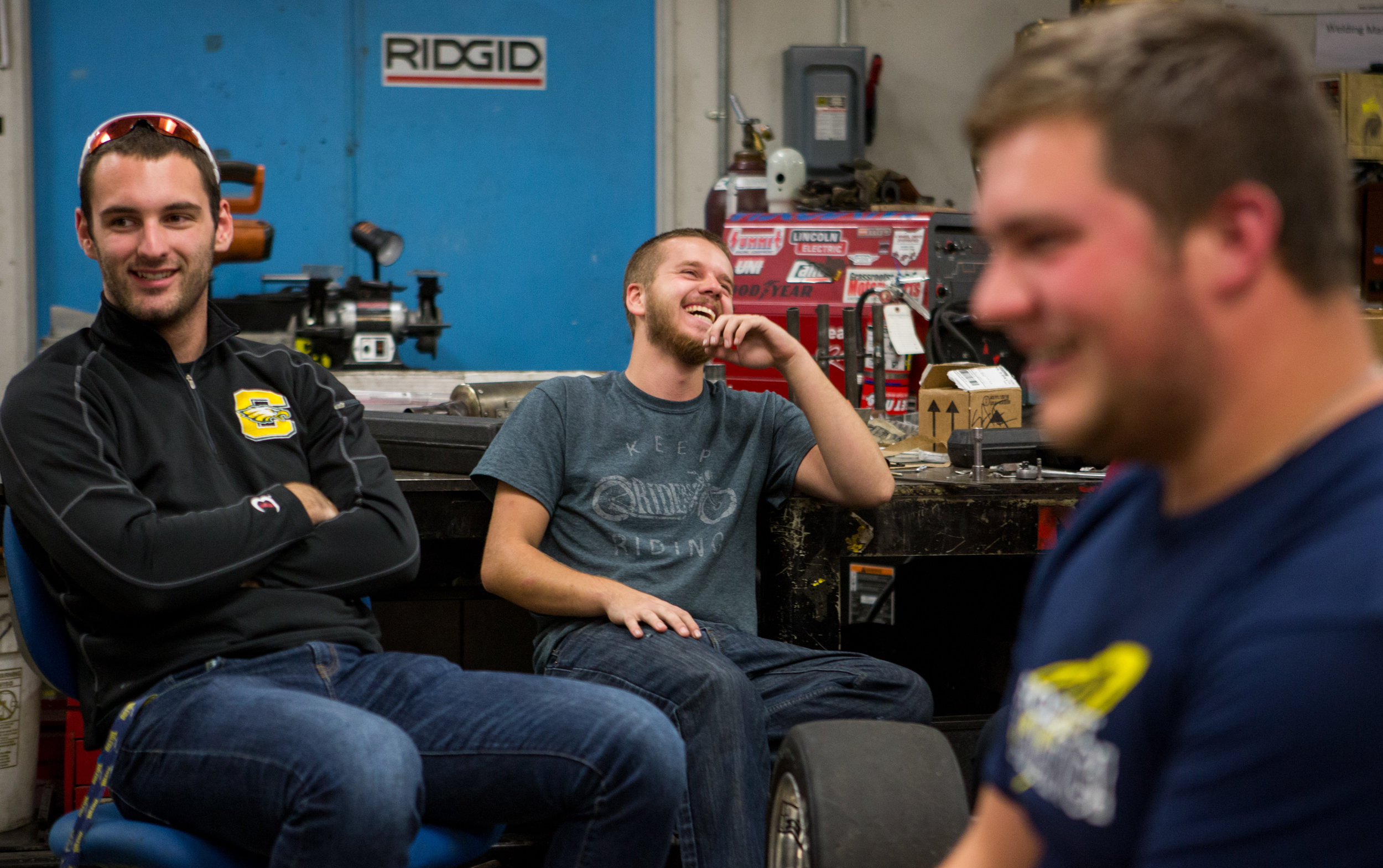Speed School
Often college means learning the nuts and bolts of life — sometimes literally.
Consider the University of Toledo, which for the past 20 years has participated in the Formula SAE program, where students engage in a “club” activity that allows them to create a Formula (open-wheeled) race car from scratch over two semesters.
University of Toledo Formula SAE members Dustin Moosman, left, and Josh Remmetler, right, push the team’s car from last season through the lobby of the North Engineering Building to take a group photo with the car.
Sponsored by the Society of Automotive Engineers, the program was launched to give students a taste of the full spectrum of the automotive industry. As detailed on SAE’s website, the concept is that a team is contracted by a fictional manufacturing company to design a Formula-style race car that will then be tested and evaluated at the yearly competition held at Michigan International Speedway in mid-May.
This means the UT team, also known as Toledo Motorsports, must start from scratch each fall, modeling every chassis tube and suspension component and perfecting the aerodynamics before driving their creation on the tarmac in seven month’s time.
UTFSAE Team lead Jacob Kennedy jots down notes in one of the team planning meetings.
“We like to say that we do about 90 percent of the car in-house,”
Braking subgroup lead Mike Day, left, and Austin Gant look at the pedal mount design from last year’s car as they plan for the current season’s car.
A sophomore in the UT mechanical engineering program, Mr. Kennedy explained that the only components team members don’t fabricate are the ones they can’t; the wheels, the engine, and shocks must be purchased rather than created.
From September to May, the team uses modeling software, welding, machining, and more in a machine shop in the school’s North Engineering building. Team members also learn about the economic side of the field. They are responsible for sourcing the materials, soliciting sponsorships, and getting funding for the parts. Public speaking is also a factor. As part of the main competition, the team must defend its design to a panel of experienced judges in a pseudo-Shark Tank environment.
Colin Jedrzejek works on cutting chassis tubing to the correct length as the team begins welding the current season car’s chassis together in the Formula SAE team lab.
While the concepts and general practices of the competition and program remain fairly consistent, Toledo Motorsports decided to break from the mold for the current season. For the last few years, the team has been recycling a similar chassis design paired to a Honda CBR 600cc motorcycle engine. This year it made the decision to change the motor to a KTM 450cc single-cylinder engine, which has caused a shake-up in the entire design of the car.
A complete redesign might seem unorthodox for a team that placed 21st out of 120 teams in last year’s competition, but as Mr. Kennedy puts it, “The team has pretty much maxed out what we can do with that [old] engine. … It got to the point that we were trying to fix something that’s not broken or trying to redesign something that’s already been gone over and over again.”
A complete redesign might seem unorthodox for a team that placed 21st out of 120 teams in last year’s competition, but as Mr. Kennedy puts it, “The team has pretty much maxed out what we can do with that [old] engine. … It got to the point that we were trying to fix something that’s not broken or trying to redesign something that’s already been gone over and over again.”
As the new semester starts, Team Motorsports is just about at the halfway point. As team members return to campus, they must still finish assembling the chassis so that the rest of the components can be installed or even designed.
Mr. Kennedy and his teammates hope to have their car assembled in time to work out the bugs before taking it to MIS in May, when their competitive rubber will finally meet the road.
While Toledo Motorsports won’t race against other vehicles, the competition includes various timed and static (design) challenges.
From left, Jared Schaufele, Josh Remmetter, and Dustin Moosman wheel the 2015 season Formula SAE car through the lobby of the University of Toledo's North Engineering Building for a team photo.
















